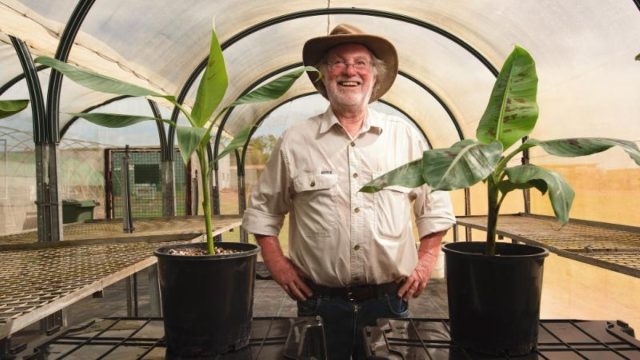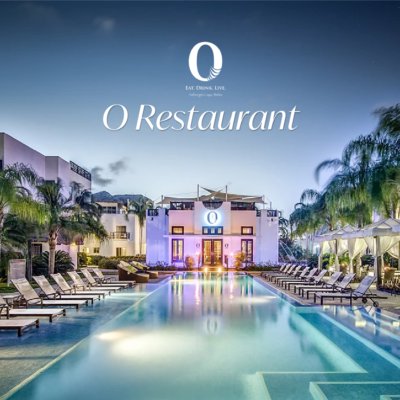
Posted: Wednesday, April 3, 2024. 9:04 am CST.
QUT professor James Dale with QCAV-4 genetically modified banana plants in the background – Screenshot from Queensland University of Technology (QUT) video
By Rubén Morales Iglesias:
In the fight to save their banana industry affected by Fusarium Wilt Tropical Race 4 (TR4 or Foc TR4), the Australian Government has approved a license for the Queensland University of Technology (QUT) to commercially release a genetically modified (GM) variety of Cavendish bananas (QCAV-4).
Here in Belize (and countries in the region) where GM varieties are unthinkable for the near future, the Ministry of Agriculture, Food Security and Enterprise (MAFSE) grapples with a contingency plan in the eventuality of a future outbreak of the TR4, which is present in Colombia and other South American countries.
A QUT article said the Food Standards Australia New Zealand (FSANZ) in February notified the Food Ministers’ Meeting (FMM) that it had approved QCAV-4 as suitable for human consumption.
While the FMM, comprising Australian and New Zealand government ministers, had 60 days to ratify the FSANZ’s decision, what is notable is that QCAV-4 is the first genetically modified banana in the world that has been approved for commercial production.
What is notable as well is that the QCAV-4 is a Cavendish Grand Nain banana. Grand Nain is one of the two banana varieties planted in Belize. The other is the Williams variety, according to Francisco Gutierrez, the Technical Director for the Plant Health Department at the Belize Agricultural Health Authority (BAHA).
The QUT Banana Biotechnology Program has been researching potential TR4 resistant banana genes for the last 25 years.
“QCAV-4 offers a potential safety net against the devastating Panama Disease tropical race 4 (TR4) which threatens the global US$20 billion banana industry,” the QUT article said.
The QUT article refers to the Fusarium Wilt (TR4) disease as the Panama Disease tropical race 4 (TR4), but Gutierrez said the two are the same.
 QUT professor James Dale with a cavendish banana plant (left) and a QCAV-4 banana plant (right) – Photo Credit: Queensland University of Technology (QUT)
QUT professor James Dale with a cavendish banana plant (left) and a QCAV-4 banana plant (right) – Photo Credit: Queensland University of Technology (QUT)
While Belize hasn’t been affected by TR4, BAHA is quite concerned with what it could cause to the banana industry. At the same time, Gutierrez said he doesn’t foresee Belize adopting a GM banana, at least not now.
“Firstly, we don’t have a policy, we don’t have a law that will prevent or accept the technology, and secondly, our main market (the United Kingdom), is still not open to it,” Gutierrez said.
“What will happen in the next five to ten years, I don’t know. It could be that Europe eases off on GM technology.”
Gutierrez also said the cost of acquiring GM banana varieties may also be prohibitive.
Meanwhile, Belize and neigbouring Guatemala, with the assistance of Taiwan’s International Cooperation and Development Fund (ICDF) and International Regional Organization for Plant and Animal Health (OIRSA), have been working to improve the contingency response plan for Foc TR4.
As part of this contingency plan, Belize has been experimenting with a resistant variety developed in Taiwan, the Formosana. Gutierrez said that the program has developed a research plot in Central Farm and two in the banana belt.
“Data is currently being collected to determine the various attributes of this variety when grown under Belize’s conditions,” Agriculture Minister Jose Abelardo Mai said in the House of Representatives recently.
“We’re trying it out to see how it performs in Belize. That’s all we can do now. Hopefully, that’s all we need to do and we’ll never have to deal with the disease,” Gutierrez said.
The Formosana resistant type bananas should be available this year as the plants mature.
The TR4 has decimated the banana industry in other parts of the world and is present in South America in countries like Colombia, Venezuela, and Peru. Gutierrez said Colombia has invested a lot into combating the disease.
In February, Colombian biosecurity expert, Dr. Catalina Quintero, led a two-day workshop with banana industry stakeholders to review the updated contingency response plan against the TR4.
Prior to that, in December 2022, six MAFSE officials received training in Colombia to control the TR4.
“The training focused on the biosecurity plan before, during and after an outbreak of TR4, the need for a robust contingency plan to manage the disease and the use of satellite imagery to assist in field surveillance,” MAFSE said at the time.
 Ministry of Agriculture officials received training banana fusarium wilt training on Colombia in December 2022 – Photo Credit: MAFSE
Ministry of Agriculture officials received training banana fusarium wilt training on Colombia in December 2022 – Photo Credit: MAFSE
The TR4 is a soil-borne fungal disease that affects the banana plant causing it to wilt. According to QUT professor James Dale, the problem with the TR4 is that the fungus can remain in the ground for more than 50 years all the while destroying banana crops and farms for generations.
Gutierrez said that one of the concerns is that the FR4 can be spread by soil. With Colombia and Venezuela being close to Panama, and the number of migrants accessing Panama in their quest to reach the United States, soil could be carried on the shoes of the migrants that cross the borders on foot.
“That increases the risk,” Gutierrez said.
“If it gets to Central America, we have migrants and it’s a matter of time before it spreads all over.”
Gutierrez said that if the TR4 disease were to get to Honduras, Belize would be in trouble.
“If there were a big outbreak in Honduras, you know how many people go and come and work in our banana industry in the South. These are some risk factors that we are evaluating and preparing for,” Gutierrez said.
So far, Belize’s banana industry comprises approximately 8,000 acres, 7,000 acres for commercial purposes and 1,000 acres of other varieties, including plantains, Bluggoe, and apple bananas.
Keeping the banana industry disease-free is paramount at this point when the industry is experiencing a recovery.
“For the first two months of 2024, we have exported $13.9 million versus $5.9 million that was exported last year,” Mai said in his House of Representatives report.
Advertise with the mоѕt vіѕіtеd nеwѕ ѕіtе іn Belize ~ We offer fully customizable and flexible digital marketing packages. Your content is delivered instantly to thousands of users in Belize and abroad! Contact us at mаrkеtіng@brеаkіngbеlіzеnеwѕ.соm or call us at 501-601-0315.
© 2024, BreakingBelizeNews.com. Content is copyrighted and requires written permission for reprinting in online or print media. Theft of content without permission/payment is punishable by law.
The post Australia grants licence to release genetically modified bananas for human consumption while Belize prepares for the eventuality of Fusarium Wilt (TR4) appeared first on Belize News and Opinion on www.breakingbelizenews.com.
Posted: Wednesday, April 3, 2024. 9:04 am CST. QUT professor James Dale with QCAV-4 genetically modified banana plants in the background – Screenshot from Queensland University
The post Australia grants licence to release genetically modified bananas for human consumption while Belize prepares for the eventuality of Fusarium Wilt (TR4) appeared first on Belize News and Opinion on www.breakingbelizenews.com.






































































